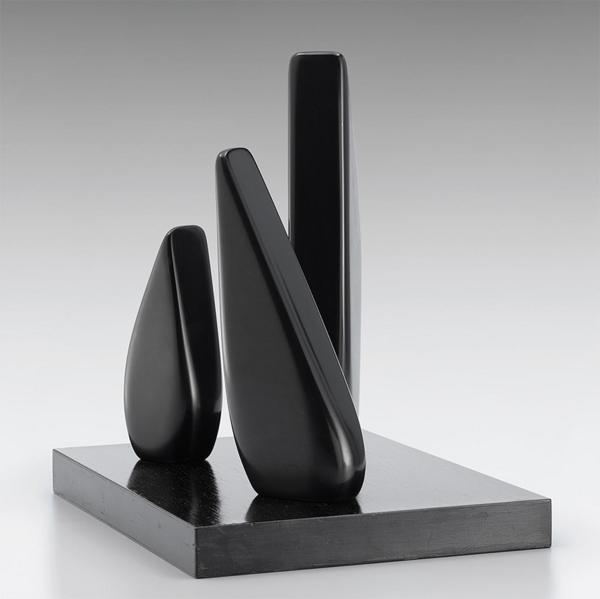Barbara Hepworth, Three Forms (Winter Rocks), 1965. 20th Century & Contemporary Art New York Day Sale, Morning Session.
NOTES FROM A PERIPATETIC COLLECTOR
When, after years of focused work, gifted young women and men begin medical school. They are often told by thoughtful deans and mentors that a wondrous big new world awaits them. But what I learned is: “not yet!” It became axiomatic that the initial two years of basic science would require grueling hours of concentrated effort. What I soon wished for was an expanded sense of freedom.
Fortunate at the time to be studying at Columbia College of Physicians & Surgeons in New York City, I found my corner of freedom by visiting the museums and galleries close by, where creativity lived and thrived. I of course quickly realized how disciplined and determined these artists were. But for me, the reaction was often awe and a hope that one day I would be free and creative as well. With honesty, my outreach was to become a form of psychotherapy. So began what was to be a sixty-year love affair with the visual arts.

Geisel School of Medicine at Dartmouth College. © 2022 Trustees of Dartmouth College.
The present works differ in composition, and in execution; they are united by a materiality and presence which together embodies a freedom of movement found, of all places, in sculpture. Substance, quality, and place – tenets of the peripatetic school of thought – are each explored in different ways by these artists, and yet they each arrive, brilliantly, in motion. As part of our 20th Century & Contemporary Art New York Day Auction, the sale of these works will benefit the Geisel School of Medicine at Dartmouth College.
Sir Anthony Caro
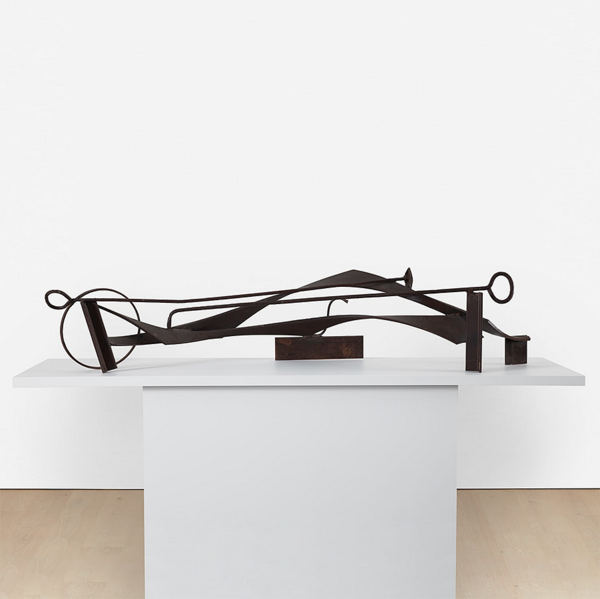
Sir Anthony Caro, O.M, R.A., Table Piece CCCXXXVI, 1976-1977. 20th Century & Contemporary Art New York Day Sale, Morning Session.

Sir Anthony Caro. Image: © David Farrell. All rights reserved 2022 / Bridgeman Images.
At the core of Sir Anthony Caro’s practice is a diagnostic engagement with the human body. Through his found materials like rusted steel, we observe objects destined for purpose, specific shapes, functions and dimensions, relieved of their prescribed roles as organic forms. As Caro’s table pieces are freed from their plinths, we are able to take them in from all angles – we rust and bend out of shape; things appear and disappear from their resting state; and we connect through a relationship with space.
As with so many of his works, Table Piece CCCXXXVI has a reflective quality – its elongated shape is bookended by staves, drawing the eye from end to twisting end in the manner of musical notation. Caro’s spatial rendering invites a contemplative tour around the work for the viewer to find new perspectives and interpret their relationship with the piece; the process is one of the sculpture revealing itself. Executed around the time of Caro’s retrospective at The Musem of Modern Art, New York, in 1975, Table Piece CCCXXXVI is a standout, elegant work from a fruitful period in Caro’s practice.
Barbara Hepworth
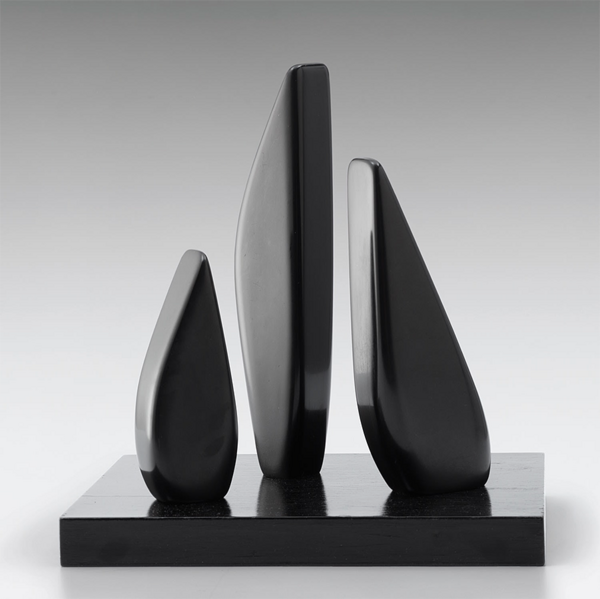
Barbara Hepworth, Three Forms (Winter Rocks), 1965. 20th Century & Contemporary Art New York Day Sale, Morning Session.
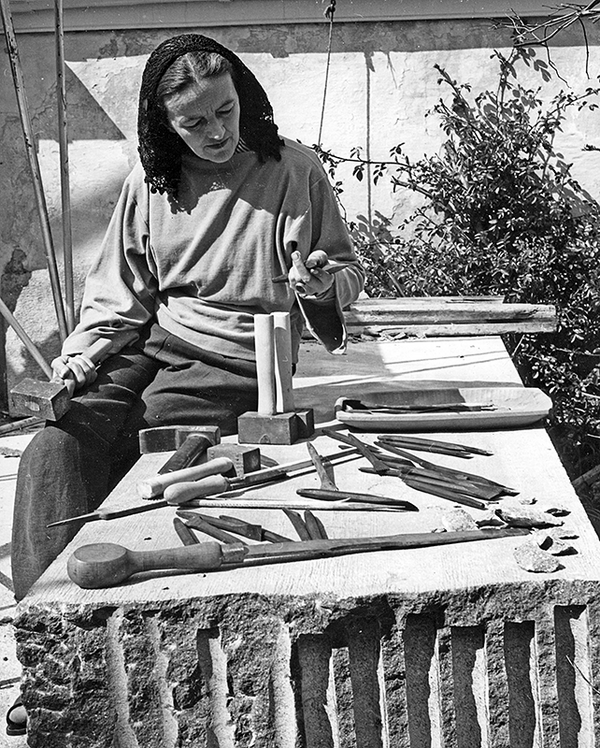
Barbara Hepworth. Image: © Brooklyn Museum of Art / Gift of Wayne and Stephanie Mones at the request of their father, Arthur Mones / Bridgeman Images.
Executed in 1965 at the peak of Barbara Hepworth’s career, Three Forms (Winter Rocks), is a prime example of the artist’s unique experimentations with material and space. One of the first of approximately sixty sculptures carved in slate Hepworth made between the 1960s and 1970s, the work is characterized by its smoothness, richness in color, and polished finish. The work’s title also emphasizes the use of three separate elements. The importance of three in Hepworth’s practice began as early as the 1930s. She made her first three-part sculpture in 1935, after giving birth to triplets the previous year, and she continued making variations of three-part compositions throughout the years. While the three forms in the present work are differently sized and imperfect in shape, the space between them is proportional to each other, demonstrating the artist’s always harmonious arrangements of form.
Hepworth’s commitment to space and material is enacted through figuration. In her own words, she was “absorbed in the relationships in space, in size and texture and weight, as well as the tensions between forms,” which allowed Hepworth to find naturalistic form in an otherwise abstract vernacular. Three Forms (Winter Rocks) takes reference from the rock formations at St. Ives, Cornwall, connecting the work to one of the main themes in Barbara Hepworth’s practice — forms in landscape. The sculpture is shaped by its environment just as a rock formation alters the movement of a breeze through it.
Dorothy Dehner
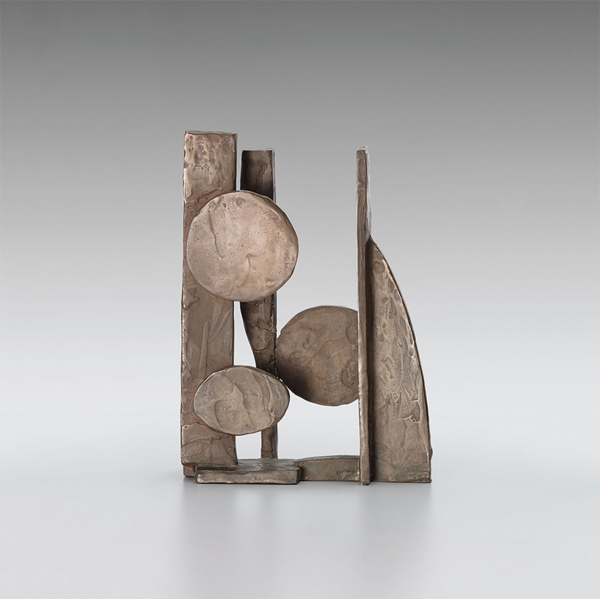
Dorothy Dehner, Untitled, 1967. 20th Century & Contemporary Art New York Day Sale, Morning Session.
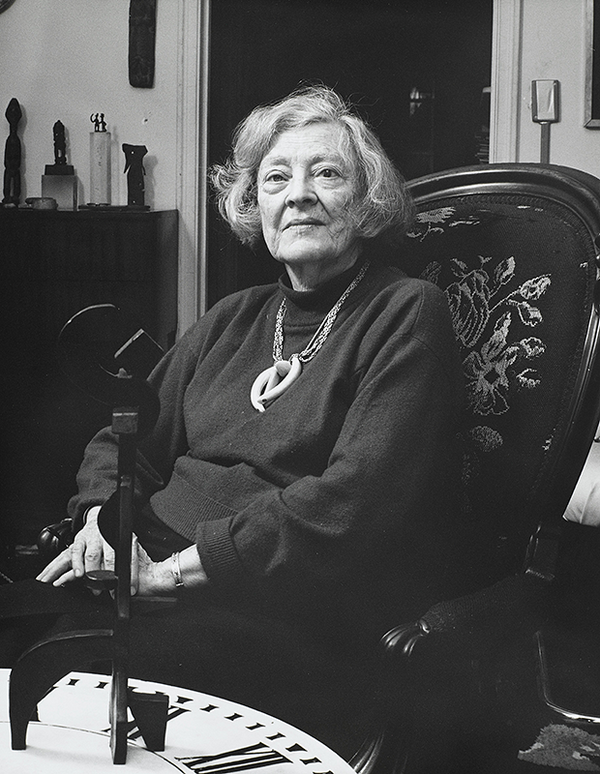
Dorothy Dehner. Image: Pictorial Press Ltd / Alamy Stock Photo.
It was not until she was in her late 40s, and after separating from her husband, the Modernist artist David Smith, that Dorothy Dehner became a sculptor in her own right. Trained as a performance artist and dancer, Dehner approached sculpture through its physicality, interpreting form and movement the way a dancer alters their figure in fluid gestures across a space. In Untitled, oblong and circular discs weave along a straightened axis, its individual elements meeting only where they create a layering effect.
Dehner’s choice of bronze is also noteworthy, especially in relation to the other two pieces in the present collection. Traditionally a casting alloy, here the artist instead embraces the material’s shape by hand, showcasing her formation through imperfect shapes. It is also a triumphant metal, one which signals victory and internal resolve even as its sheen tends to oxidize. Perhaps this was a consideration and symbol of Dehner’s tumultuous past and her reinvigoration as a sculptor – an emotional landscape rendered physical in three dimensions; a small, inconspicuous monument to liberation. As the artist notes: “I was never taught sculpture at all; nobody told me anything. I didn’t need it. The minute I had (the wax) in my hands, I knew what to do.” Recently, Dehner’s output has received a renewed spotlight with its inclusion in shows around the United States, including an auction record in 2020 and inclusion in a 2021 group exhibition at Rosenberg & Co., New York, entitled A Future We Begin to Feel: Women Artists 1921-1971.
Discover More from 20th Century & Contemporary Art >
Recommended Reading
A Glimpse at Two Rare, Early Andy Warhol Paintings >
Cy Twombly's Monumental 'Bacchus' Painting Comes to Phillips New York >
